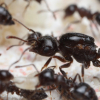I know they can be harmful, and I don’t treat it as rhetoric, but in my neighborhood, some Tetramorium colonies disappeared and were replaced with Lasius and vice versa.
I'm still on the fence about Tetramorium immigrans. As it has been naturalized. And it's not going anywhere, so might as enjoy it. I could make the same argument against rats . The biggest problem would be telling the difference between Tetramorium immigrans and the more unpleasant Tetramorium tsushimae which are more problematic towards ground nesting ants . Tetramorium immigrans is still being and whole Tetramorium Sp. Is still needs a lot of work, they form hybrids
Fairly easy and with having such a large geographic range in the U.S. Tetramorium immigrans has been kept for years now by many ant keepers,formally known as Tetramorium caespitum. So can see that there's a lot of confusion about what we refer to as "Tetramorium" among scientists and researchers. I don't know who will see this I'm not very good at this forum based communication. But in closing, sometimes it's good to just enjoy life. Because are no guarantees of anything and Mother Nature always wins.
Just wanted to comment on this further.
Like I mentioned previously, areas where they are absent have an astonishing level of biodiversity compared to areas where they are present. Yes, they are not like Paratrechina longicornis or Linepithema humile and wipe out all other ant spp., but they do cause significant damage and make it impossible for many of our natives to survive.
Recently, when I was in Northcentral Illinois I found Pheidole bicarinata in a subway parking lot. Anybody who lives in the Midwest would be astonished. Why? Because this was a very rural community and Tetramorium immigrans had not spread to it. They are a death sentence for many of the 'cooler' species we have in the temperate US.
You guys are correct about Tetramorium tsushimae being far worse. I saw them when I visited St. Louis. They are like Paratrechina longicornis or Linepithema humile. Possibly even worse. When I found them, I found 0 other ant spp. Maybe the small cryptic species were present, but not in any significant number. This is likely due to their supercolonial nature, same as with the aforementioned species. While they are damaging like that, the scary thing about them is not that they are pushing out Tetramorium immigrans. It's that unlike them, they are able to survive in undisturbed habitats. In theory, this is what can cause extinction events for certain species. Tetramorium immigrans cannot penetrate into undisturbed wilderness, and even if they kill off the native ants in disturbed areas, they won't be able to completely destroy their entire bloodline. The same cannot be said for T. tsushimae.
Furthermore, even just a small impact that one person makes by consciously damaging them does make a significant difference. Take AnthonyP163's yard for example. By consciously hurting their populations, you are able to see native species start bouncing back. Since those colonies then produce alates, it has a domino effect. They may seed hundreds or thousands of native colonies. While yes, they are likely to suffer due to Tetramorium immigrans wherever they found, at least they have a chance at surviving. So even just a singular yard free of T. immigrans could go on to impact the entire diversity of your immediate neighborhood.






















